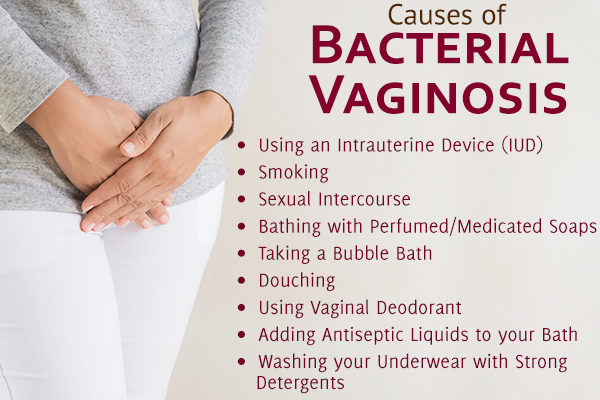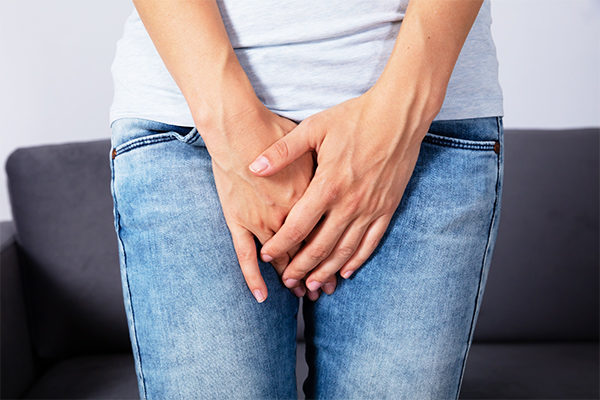In this article:
Bacterial vaginosis (BV) is a vaginal infection caused by an overgrowth of certain bacteria. The vagina normally harbors a balance of different bacteria.

In most cases of BV, the growth of Gardnerella vaginalis (harmful bacteria) in the vagina causes a decrease in the Lactobacillus (healthy bacteria) population. BV can also be caused by the growth of other bacteria that are capable of replacing the good bacteria. (1)(2)
Causes of Bacterial Vaginosis

BV is caused by an imbalance in vaginal microflora. The reason behind the overgrowth of harmful bacteria is not precisely known. However, certain factors can make you prone to the infection, some of which are:
- Using an intrauterine device (IUD)
- Smoking
- Sexual intercourse, especially when you have multiple partners
- Bathing with perfumed or medicated soaps
- Taking a bubble bath
- Douching
- Using vaginal deodorant
- Adding antiseptic liquids to your bath
- Washing your underwear with strong detergents
While sexual intercourse is one of the biggest risk factors for BV, women who haven’t had sex can still get infected. (3)
Symptoms of Bacterial Vaginosis
Common symptoms of BV include:
- Itching around the vaginal area
- Malodor in the vaginal discharge
- Abnormal discharge from the vagina
These symptoms may worsen after sexual intercourse or after a menstrual cycle.
A “fishy”- smelling, grayish, or yellow vaginal discharge can be observed, which is usually thinner than that caused by yeast infections. (4)
Who Should Get Tested for Bacterial Vaginosis?
If you experience any symptoms of BV, seek medical attention. In the absence of symptoms, screening for BV may be necessary in the following cases:
- During pregnancy: Get yourself tested if you have vaginal discharge, as BV can increase the risk of preterm delivery.
- Before gynecological operations: BV can increase the risk of infection after surgery.
Treatments for Bacterial Vaginosis
BV can be treated with prescription medications in the form of gels, creams, and pills. Antibiotic pills, creams, and capsules are prescribed to stop the growth of harmful bacteria. In pregnancy, antibiotic pills are the only option. (5)
The antibiotics that are generally prescribed include:
- Clindamycin: Cleocin
- Metronidazole: Flagyl or MetroGel-Vaginal (6)
Note: Do not consume alcohol for 24 hours after taking metronidazole.
BV symptoms subside within 3–5 days of starting the treatment. However, it is necessary to complete the treatment to prevent a relapse of the infection.
Preparing for Diagnosis
Before being tested, you need to take the following preparatory measures:
- Avoid using vaginal irritants such as sprays.
- Do not insert anything, such as a tampon, in your vagina.
- Schedule your appointment on your non-menstruating days.
- Avoid douching or using any vaginal medication for at least 3 days.
- Do not have sexual intercourse for 24 hours before the test.
Diagnosing Bacterial Vaginosis

Diagnosing BV begins with a medical history, a physical examination, and lab tests by a medical provider to check the discharge and presence of malodor if any.
Samples of vaginal fluids are collected for the following laboratory tests for the diagnosis of BV:
- Wet mount
- Vaginal pH
- Whiff test
It is recommended to get checked for STIs, as they may occur at the same time as BV.
Complications of Bacterial Vaginosis
BV can give rise to the following complications:
- The harmful bacteria may increase the risk of infection in the fallopian tubes or uterus, including pelvic inflammatory disease.
- There is an increased risk of contracting infections after operations, such as a cesarean section or surgery of the uterus, in patients suffering from BV.
- BV can also cause premature birth or early labor. (7)(8)
When to See a Doctor
It is recommended to see a doctor as soon as you experience any symptoms associated with vaginal infections. A proper diagnosis is needed to differentiate between BV and other infections.
Seek immediate medical attention if you have a vaginal discharge along with lower abdominal pain and a high fever (above 101°F).
Expert Answers (Q&A)
Answered by Dr. Candice Fraser, MD (Obstetrics and Gynecology)
Boric acid is beneficial in treating recurrent BV. (9) Gynecologists may recommend several different treatment regimens. I usually recommend a 21-day course after treatment with the standard antibiotic.
Boric acid suppositories can be obtained from a compounding pharmacy, but there are now some reputable over-the-counter brands that supply the recommended 600 mg dose.
Yogurt with live lactobacilli has been shown to have benefit in the treatment of BV. However, there is no definite recommendation on how much yogurt needs to be taken. (10)(11)
To be most effective, the yogurt should contain live Lactobacillus acidophilus. There are some recommendations that eating 8 oz of yogurt daily for a week can be helpful.
If left untreated, BV may resolve on its own, but it is more likely to cause more irritation and discomfort. The most concerning thing about untreated BV is that it increases the risk of contracting an STD if one has sex with an infected partner.
To protect against BV, practice “less is more.” In general, the vagina is able to maintain its pH balance, being colonized by lactobacilli. To keep this balance, avoid soaps and douches in the vagina, wear cotton underwear, change out of wet underwear and pants as soon as possible, and wear condoms if feasible.
Additionally, keep the vagina dry when possible. Incorporating a probiotic with live lactobacilli, either in yogurt or a supplement, can also be effective in preventing recurrences.
Final Word
Bacterial vaginosis is a common reason many women seek medical attention. Women with BV should be tested for other sexually transmitted infections as well. If pregnant, any abnormal discharge or itching should be evaluated.

- Was this article helpful?
- YES, THANKS!NOT REALLY



